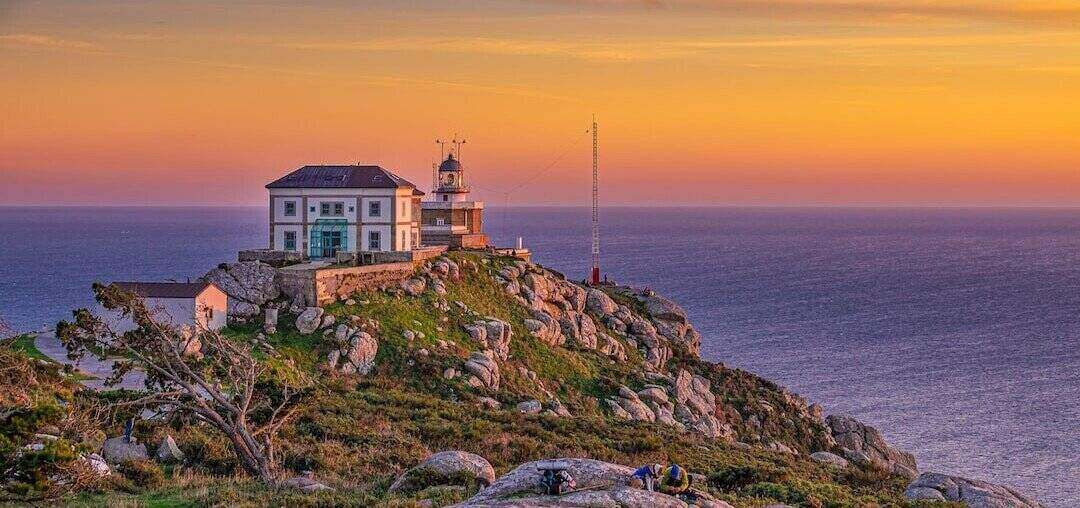Fisterra: Pilgrims, Legends and Beauty
Fisterra is a small coastal town in western Galicia, known for its spiritual significance and breathtaking Atlantic views. It sits about 100 kilometres beyond Santiago de Compostela and offers pilgrims a final, symbolic destination after reaching the city’s famous cathedral. Many walkers extend their journey along the Camino Finisterre to reach this powerful edge of land and sea.
Here, the Atlantic Ocean stretches endlessly into the horizon, offering a deep sense of reflection and closure. Fisterra is not just a place on a map. It’s where countless journeys pause, shift, and renew.
Table of contents
Pilgrimage, History and Symbolism
A Sacred Final Step
Fisterra has drawn pilgrims for centuries, long after their official Camino ends in Santiago. The walk west leads through peaceful villages, forests, and hills. Eventually, Cape Fisterra and its iconic lighthouse rise above the rugged coastline, welcoming pilgrims with windswept cliffs and ocean spray.
In the Middle Ages, many came to Fisterra to worship the image of the Sacred Christ kept in the town’s chapel. Today, pilgrims come for different reasons—some spiritual, some emotional, others simply curious. But nearly all share the feeling of ending something meaningful.
The Roman Name: End of the World
Fisterra’s name comes from the Latin “Finis Terrae,” which means “Land’s End.” The Romans believed this headland marked the edge of the world. Beyond the cliffs, only ocean remained.
This ancient belief gave Fisterra a mythical quality, which still lingers in its sunsets, weather, and coastal scenery. The sea meets the sky here in a way that invites quiet and wonder.

Rituals and Symbolism
In the past, pilgrims would burn clothing or shoes on the rocks at Cape Fisterra as a ritual of closure. This act represented rebirth or purification, but the local authorities have since banned it due to environmental damage.
Today, many pilgrims choose to swim in the Atlantic instead. The cold water offers a meaningful and respectful way to celebrate their journey’s end. Standing by the lighthouse as the sun sinks into the sea is another common ritual. The moment feels shared and silent, as if time itself pauses.
Myths, Stones and the Coast
The Costa da Morte
Fisterra sits along the Costa da Morte, or Coast of Death—a dramatic stretch of shoreline known for its shipwrecks and storms. Despite the name, this part of Galicia is deeply beautiful. Its cliffs, sandy beaches, and wild seas form a striking natural stage.
Many believe this coastline holds deep energy, shaped by both danger and beauty. The sea here is both giver and taker—full of stories, legends, and quiet warnings.
Altars to the Sun
Ancient myths speak of Ara Solis, a sun-worship altar said to stand near Fisterra. Some say it was built by Phoenicians. Others claim it belonged to Celtic tribes.
Pre-Christian communities believed this region marked the boundary between the land of the living and the land of the dead. Fisterra still carries these echoes in its rocks, water, and winds. Even today, the blend of belief, nature, and heritage is felt everywhere—especially at sunrise and sunset, when the sky glows.

Mysterious Stones and Local Legends
Large stones scattered across the region have long been associated with legends and magical properties. Some are called “holy stones” or “rocking stones.”
The Pedra de Abalar in Muxía is the most famous. This massive stone is said to rock on its own. Local folklore says it can reveal guilt or innocence or warn of disasters like storms or shipwrecks.
Other stones are thought to cure illness or protect travellers. Whether fact or fiction, these legends still shape local identity and culture.
The Virgin’s Journey
One famous tale says the Virgin Mary arrived in Galicia on a stone boat to support Saint James in his mission. That boat is believed to have turned into stone and now rests near Muxía.
Such stories tie together Fisterra’s Christian roots and older, pre-Christian traditions. The town’s energy seems to come from many layers of history.
Faith, myth, nature, and local belief are woven together in a unique and powerful way along this coast.

Fisterra Today: Beauty and Reflection
Modern Fisterra still welcomes pilgrims, travellers, and dreamers seeking something beyond the ordinary. Its quiet streets, stone buildings, and sea air invite calm.
Many visitors say they feel something special here—something they cannot explain, but deeply understand. The cliffs and sunsets offer moments of stillness that stay with people long after they leave.
Fisterra may be called “the end of the world,” but for many, it becomes the beginning of something new. The journey ends here, but something else always begins.
To book the Camino Finisterre or any of the Camino routes, please don’t hesitate to get in touch with us. Our team is here to guide you through the booking process, answer any questions you may have, and help tailor the journey to suit your preferences.
You can also get an instant quote today using our Camino Planner – it’s quick, easy to use, and a great way to start planning your adventure.
